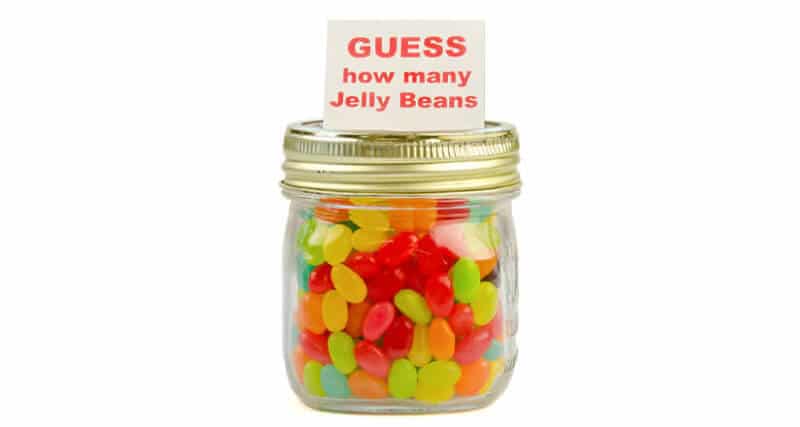Estimation Stations: An Integrated S.T.E.M. Lesson
Overview
In this project, we will learn to use an array of estimating methods to achieve the most accurate count. This small, group-based project will have students visiting various centers throughout the room for the duration of a class period. This lesson is geared up for students in grades 6-8.
Designed to accommodate your S.T.E.M. budget, you will use a variety of measuring tools and devices including mason jars, jellybeans, ruler, pan balance, small paper cups, and water basin.
Prior to the lesson, the teacher should count out a set number of jellybeans to completely fill a jar. This number should be kept secret. Then set up each station.
- Station 1 – Full Jar
Station 1 includes the complete mason jar full of jellybeans. The actual count is known only to the teacher. However, students at this station can examine the jar and visually inspect the number of rows of beans and see how many beans it takes to fill the bottom row by turning the jar on its side.
- Station 2 – Pan Balance
Station 2 has a pan balance with weights and an identical full jar of jellybeans. In addition, there is an empty jar, and some lose jellybeans. The idea behind this station is that students will be able to weigh the full jar and then weigh the empty jar and then subtract the two measures giving the weight of the beans alone. Then, measuring the weight of one bean, divide that number into the weights of the beans alone giving an estimate as to the total.
- Station 3 – Row Count
The third station includes a cup of loose beans and an empty jar identical to the full jar from station one. The concept of this station is that students will be able to count the number of jellybeans that it takes to complete one row of the jar and then multiply this number by the number of rows they counted in station 1 or by the number of rows they estimate it will take to completely fill the jar.
- Station 4 – Volume I
This station contains an empty jar identical to the jar in station one. In addition, there is a ruler and a single bean. Here, student groups will measure the volume of the jar. They will do this by measuring the radius of the jar (in millimeters), then squaring this number and then multiplying it by the height of the jar (in millimeters) and then by 3.14 (our estimate for Pi). This is the volume of the jar in cubic millimeters. Then students should approximate the volume of one bean. This is not an ideal cylinder, but the students can measure the approximate height and radius in millimeters and follow the same formula as that of the jar. Finally, students should divide the volume of one bean into the volume of the jar to get their estimate.
- Station 5 – Volume II
This station contains an empty jar identical to the jar in station one as well as a cup of jellybeans, and empty cup identical to the full cup, and a water basin (filled with water). At this station, students will count the number of beans it takes to fill one cup, then they will use the empty cup and water to count the number of cups of water it takes to completely fill the jar. They are to then multiply the number of beans in the cup by the number of cups it takes to fill the jar in order to get their estimate.
- Station 6 – Discussion and Submission
The final station is where student groups get to discuss their findings and the results of each station. This is also where they make their final estimate submission: what they think is the closest estimate as to the actual number of jellybeans in the initial jar.
Introduce the lesson by discussing what an estimation is, what goes into making an estimation, and how it can be a useful skill. Then have student groups rotate to each station for approximately five minutes each or until they have enough time to complete the calculations for that step. Have classroom calculators available to make short work of the math. After all stations are complete, reveal the actual count and compare it to the results of the student groups.
Science
The science behind this project is the ability to make predictions and then test those theories as to which is most accurate method of estimating. Students may find that the methods they thought would be most accurate contained flaws that led to a miscalculation. They could then analyze those flaws and try to adjust for the correction.
Technology
The technology that made this project work was the tools involved. The tools here included traditional measuring devices such as the ruler and pan balance. These tools were primitive, but if used properly, could be very effective.
Engineering
The engineering could be witnessed in the use of non-traditional measuring tools. For example, in multiple stations we used cups of beans and water to estimate volumes of containers. The instructor could make this a more challenging lesson by not telling the student groups how to use the tools at each station. Student groups would then have to engineer a plan for each station.
Mathematics
Some level of mathematical calculations occurred at each station. There was the use of a pan balance, row counting, volume formula and estimations. Teachers can make mini lesson on the use of the pan balance and volume formulas.
Extend-Expand-Explore
Extend the lesson by using other sizes and shapes for the container. Consider raising the difficulty level by using irregularly shaped containers and/or not filling them completely. Expand the project to include different objects that could be the subject of your estimates. Explore other methods of making estimates.
Lesson Plan
Title: Estimation Stations
Objectives: To explore an array of estimating techniques to get the most accurate count.
Materials:
- Mason jars
- Jellybeans
- Ruler
- Pan balance
- Small paper cups
- Water basin
Procedure:
- Count a set number of jellybeans to completely fill a jar.
- Set up each station
- Introduce the lesson by discussing what an estimation is, what goes into making an estimation, and how it can be a useful skill.
- Have student groups rotate to each station for approximately five minutes each.
- Have students discuss the results of their estimations.
- Reveal the actual count and compare to the student groups.
Conclusion:
Discuss the different stations. Ask the students which station they thought would be most accurate prior to the experiment and if their opinion changed afterwards.
Check out other integrated STEM lessons in this series here.
– Christopher Masullo Ed.D





